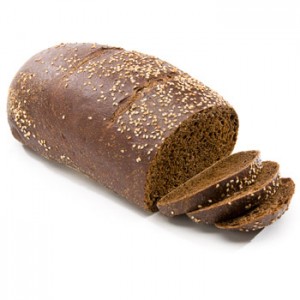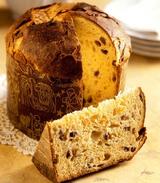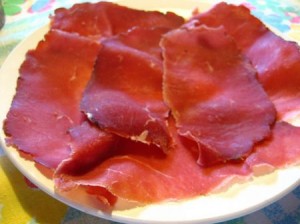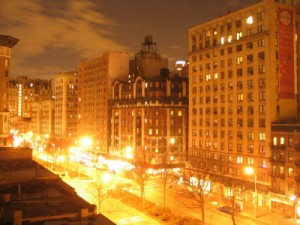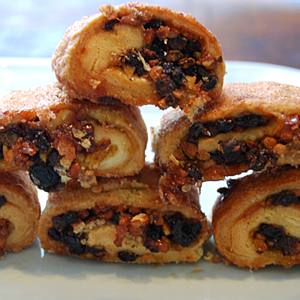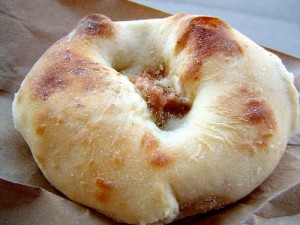Yes, ’tis the season to be jolly and adding to seasonal merriment is Panettone. The Italian sweet bread, which originated in Milan, makes its annual holiday appearance in an oddly shaped box. The bread is yeasty, fragrant and studded with raisins and candied fruit. Delicious. Like a fruit cake that is actually good to eat. It is a Christmas staple not only in Italy, but also in Brazil, Argentina and Uruguay. Italians like it for dessert (topped by a scoop of mascarpone) with a glass of sweet wine like Moscato d’Asti. HG likes it for breakfast. Gently warmed and served with marmalade or a drizzle of maple syrup. Good for dessert with vanilla ice cream. You can buy the Bonifante imported Panettone at Zabar’s (expensive); a cherry Panettone at Dean &Deluca (very expensive, naturally); a tinned one with glazed chesnuts at Williams-Sonoma (expensive) and the house brand one at Trader Joe’s (very cheap). Penny pinching HG goes for TJ’s version.
Panettone. Hooray!
December 8th, 2012 § 0 comments § permalink
Joe Brings Home Some Goodies
October 22nd, 2012 § 0 comments § permalink
Lesley R., gifted daughter of HG and BSK, has spent much time living in Italy with her family. When HG has visited them (in Bologna, Venice, Siena) meals often started with a platter of Bresaola (thinly sliced, air dried beef). Lesley covered the beef with fresh, baby arugula, good olive oil and shards of Parmesan. Splendid dish. HG hasn’t encountered Bresaola in the USA and feared an Italian trip was the only way to access this delicacy. Well, happy news. Trader Joe’s is now carrying Citterio’s Bresaola and it’s mighty good. Had it last night with arugula fresh from the Farmers’ Market.
Some more nice taste news. When HG and BSK lived in their Vancouver loft, they often enjoyed Black Cod (also known as sable — when smoked it is that lush stuff found at Russ & Daughters, Zabar’s and other New York smoked fish specialists). Vancouver chefs sometimes prepared it with a maple syrup glaze or sauce. The sweetness complemented the richness of the fish. Well, don’t want to sound like a Trader Joe’s press agent, but TJ is now carrying frozen Black Cod filets. HG has sourced a nice recipe for Black Cod with “maple syrup gastrique” — a fancy way of saying maple syrup sauce. HG is not a fan of frozen fish but HG’s had a good experience with TJ frozen sole. So, the Black Cod may be a winner. Will keep you informed.
Young New Yorkers Living in Expensive Closets: Read This And Weep.
October 10th, 2012 § 0 comments § permalink
Some 48 years ago (seems like yesterday). HG, BSK, their two adorable children, their live-in mother’s helper and their poorly trained but decorative standard poodle, lived in a 12th floor Upper West Side apartment with dramatic views of the Hudson River and the New Jersey Palisades. A very spacious residence. Big living room. Big, separate dining room. Nice windowed kitchen and pantry. Four bedrooms and three baths (one en suite). The rent: $274 a month (later raised to $292 and a similar apartment in the same building now rents for $15,000 a month). Ah, rent control, you lovely bit of legislation (of course, obtaining this rent controlled paradise involved some bribery, chicanery and corruption). This did not shock HG, a born and bred New Yorker. In those days the Upper West Side was affordable and diverse. There was still a heavy Jewish influence. Big time theater and entertainment folks (Abe Burrows, Leonard Bernstein, Isaac Stern and many more) lived on Central Park West alongside many affluent professionals and business persons. Side streets from Central Park West to Broadway were gritty (except for W. 67th Street, site of the Des Artistes apartment house and many studios of painters and musicians). Riverside Drive and the Avenues and cross streets west of Broadway were filled with intellectuals and creative types who had more brains and talent than money. Forget Greenwich Village. The Upper West Side was the home of professors, critics, novelists, dancers, journalists, composers, actors, musicians and school teachers. Lots of European intellectuals who had fled Hitler and many Holocaust survivors (the little, pale, Nobel Prize winning writer, Isaac Baashevis Singer, who lived on W. 86th Street, often wrote about them). The Heresford (West Side apartment houses often had British names, a touch of Anglophile class) where HG and BSK lived, had much artistic ferment. Among its residents were Peter Boyle (before Hollywood and TV fame); film composer Michael Small, the critic and editor Ted Solotaroff; Gary Null, the health and sex writer, guru and radio personality. There were also some Broadway dancers, the cantor of a major synagogue and lesser artistic lights. The Upper West Side was filled with movie theaters showing art films (the New Yorker, Thalia and Symphony) and plus the first run houses (Loew’s 83rd, the Beacon,etc.). Food was a neighborhood obsession. Zabar’s, of course, but also Murray’s (preferred by some smoked fish aficionados) and Barney Greengrass (unsurpassed sturgeon). Middle European restaurants like Eclair and dairy restaurants like Steinberg’s and Paramount. Gitlitz’ Delicatessen on Broadway and 78th ( much superior in HG’s informed opinion, to Katz’s, Carnegie or 2nd Avenue Deli). The jewel of the West Side was the Tip Toe Inn (on Broadway near 86th Street). A huge place with a huge menu. Everything was delicious and inexpensive (the New York Public Library has a nice collection of old menus….Here’s a link to Tip Toe’s 1954 menu. Be astonished). There was a rotisserie in the Bretton Woods Hotel (86th and Broadway) that barbecued ducks and chickens. Sunday dinners for HG and BSK often featured one of those juicy, crisp skinned ducks and an avocado-sweet onion-sliced orange salad. Chinese restaurants were clustered around Broadway and 96th and they were very good (the first Szechuan restaurant in New York was on Broadway and 95th). There were also some Cuban/Chinese places where you could get good shrimp dishes plus Moros y Cristianos (black beans and rice) Fairway didn’t exist but for those who liked to eat at home there were butchers like Endicottt Meats and Nevada Market (where you could get some exotic stuff including bear, in season). Good bakeries. Mom and Pop greengrocers. Citarella’s for fish. Broadway Nut Shop for sweets. Daitch Dairy (79th and Broadway) for tub butter and cheese. Bretton Wood Rotisserie for barbecued ducks. HG and BSK were not plutocrats but could afford all of these good things. Yes, the Upper West Side had lots of junkies, hookers, muggers and burglars. Their presence made West Siders feel superior to residents of the antiseptic Upper East Side. Now, let HG make you young folks really jealous. HG, BSK and family spent all summer plus spring and fall weekends at their Fire Island home. Built atop a dune it had panoramic views of the Atlantic Ocean and Great South Bay sunsets. The family bought it for $40.000. HG’s first Fire Island house (in 1959) cost $4,000 ($1,000 for land and $3,000 for two bedrooms, bathroom, kitchen, living room and deck). In 1960, HG added two more bedrooms, another bathroom and additional decking. Cost: $2,000. That’s right. The numbers for these Fire Island properties are correct. Read and weep.
Happy New Years! Make it a Sweet One!
September 19th, 2012 § 0 comments § permalink
Happy New Year to one and all. Rosh Hashonah, the Jewish New Year holiday, has just passed and solemn Yom Kippur, a day of fasting and atonement, will soon be here. This leads HG to a remembrance of a Jewish Tom Sawyer moment when HG was a growing and ever-hungry ten-year-old. HG’s mother and father were secular, left wing socialists. However, in a bow to tradition and identification with their fellow Jews, they observed the High Holy Days. HG’s father attended synagogue on Rosh Hashonah and Yom Kippur was a day of fasting (which ended in an exuberant feast). One autumn, HG’s Mom prepared a big tray of rugelach for the fast-ending Yom Kippur dinner. Yes, you can buy rugelach today from Zabar’s, Dean & DeLuca and many other sources. These yummy Eastern European pastries have entered the foodie mainstream. However, current day rugelach are only pale imitations of HG’s Mom’s cinnamon, raisin, walnut stuffed wonders. Little HG was a rugelach junkie. One wasn’t enough and a dozen weren’t too many. On that memorable Yom Kippur day many years ago, little HG came home and discovered the tray of rugelach cooling in the pantry. The HG family lived on the ground floor of a two family house and the pantry could be entered through a separate rear door. Hungry HG discovered the apartment was empty and this gave him the opportunity to do the forbidden: Eat on Yom Kippur and devour rugelach meant for the celebratory dinner. Well, naughty HG ate a rugelleh (the singuar of rugellach. HG rearranged the tray so his theft would not be discovered. This made HG even hungrier so HG ate another rugelleh. Yes, gluttony took over and the bad boy ate every pastry on the tray. Mom came home and discovered the theft. Obviously, rugelach burglars were at work. “Goniffs came in through the back door. I’m calling the cops,” she shouted. HG had to confess. No hitting but many angry words. Fortunately, Mom had made a big lekach, a honey cake. At dinner that night the family had wedges of the cake and toasted the new year with shots of Park & Tilford rye whiskey. All made wishes for a sweet new year. Little HG was forgiven. After all, his pastry felony could be interpreted as a loving testimonial to his Mom’s baking skills.
Beautiful Baked Goods
February 8th, 2012 § 1 comment § permalink
HG misses the high caloric New York breakfast treats of yesteryear. Greenberg’s Sticky Schnecken Buns. These honey, nut and cinnamon drenched little guys were more addictive than heroin. Sold by a shop — William Greenberg Jr. Deserts — on Madison Avenue, they were expensive and madly delicious. It took self discipline not to demolish an entire box before they were brought home. 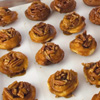 When the effects of weed smoking brought about a passion for sweet goodies, all senses cried out for the Greenberg’s product. Apparently Greenberg’s son is alive and well and making these wonderful buns according to his father’s recipe which are for sale HERE.
When the effects of weed smoking brought about a passion for sweet goodies, all senses cried out for the Greenberg’s product. Apparently Greenberg’s son is alive and well and making these wonderful buns according to his father’s recipe which are for sale HERE.
Croissants from the Sutter bakery on Greenwich Avenue in The Village. Flakey, crisp, outrageously buttery. Much superior to anything in Paris. BSK was partial to slices of Zito’s bread (from the old Bleecker Street bakery which closed in 2004) drenched with honey. With softly scrambled eggs, HG liked buttered Jewish rye or Pechter’s (or Stuhmer’s) pumpernickel (obtainable at Zabar’s).
Sometimes nothing tasted better than a warmed (not toasted) bialy liberally smeared with Daitch’s cream cheese (or Zabar’s scallion cream cheese). HG never fancied bagels. HG is concerned that bialy baking has entered a period of decline (are the old masters dead or basking in Florida sunshine?). Have not had a truly great bialy in years. Sadly, bialys shipped recently by HG’s much loved Russ & Daughters didn’t have that old time oniony zest. (SJ will interject now. The old time great bialy still exists at Kossar’s Bialys on Grand Street. A serious treat when warm from the oven and eaten whole right from a brown paper bag. Says SJ: You wouldn’t order fish from a baker, so don’t order bialys from an appetizing store.)
Possibly the best breakfast treat of all was the “pletzel.” This was a roll covered in baked onions. Good? As my Mom would say: “Nu,nu, don’t ask.” These were on the table at Jewish dairy restaurants like Ratner’s and Rappaport’s on the Lower East Side and at Jewish bakeries throughout The Bronx. Gone, all gone. HG’s eyes grow misty.
Quack Quack
January 14th, 2012 § 0 comments § permalink
New York Times had a story on the duck lunch at David Chang’s Ssam Bar and the “duckavore” dinner at Wong in the West Village. Duckalicious. The descriptions of the ducky delicacies were so riveting and appetizing that HG was tempted to leave for The Big Apple post haste. However, HG stayed put and ransacked his memory for tasty webbed foot treats.
Best duck dish ever was the braised duck with olives at the late Le Pavillon. Crisp and juicy, the abundant richness of duck fat cut by the sting of the olives. A runner up was the crackling Peking duck at the Peking Duck House in New York’s Chinatown. When in Paris, HG often indulges in the ubiquitous duck confit; however, the best HG has ever tasted came not from Paris, but was found behind the counter of Oyama, the great French-oriented charcuterie and cheese shop located in Vancouver’s Public Market on Granville Island. In Chinatown (both in New York and Vancouver), HG often does a simple (and cheap) lunch of barbecued duck and pork plus a bowl of rice and pot of tea.
During their ten years of residence on Manhattan’s Upper West Side, HG and BSK had a tradition of late Sunday dinner a deux (little ones safely snoozing). The duo devoured a rotisserie barbecued duck from the Bretton Woods Butcher on W. 86th Street accompanied by a salad of sliced orange, sweet onion and avocado. Then, a crusty baguette, runny brie. Two bottles of red wine. A nice way to close the weekend.
Yes, Sunday was a day of indulgence in HG and BSK’s rent controlled paradise. The day began with a breakfast of Zabar’s smoked salmon, sable, scallion cream cheese, bagels and bialys. The fat Sunday Times on the table. It was all worked off with long bike rides in Central Park. SJ strapped to HG’s back. Little Miss LR in a kiddie seat. Peaches, The Wonder Dog, racing along on a leash. Happy memories of food, fun and family — a ducky time, indeed.
The Golden Age of Food On The Upper West Side.
December 21st, 2011 § 182 comments § permalink
It was 1963. HG and BSK were beginning their marriage in an artist’s studio apartment on West 67th Street just off Central Park West. Huge high ceilinged living room with north facing floor to ceiling window, small kitchen, small bedroom ( former model’s changing room), big bathroom with enormous tub. Very romantic. The rent: $140 per month.
This was The Golden Age Of Food On The Upper West Side. Gentrification and escalating real estate prices removed the gritty, funky luster. The neighborhood had junkies, muggers, burglars, hookers and bag ladies. It also had tons of artists, writers, academics and free ranging intellectuals lured by big apartments and cheap rents.
Here’s a smattering of the food and drinks establishments that delighted the newlyweds: 67th St. Wines (67th and Columbus): Splits of good champagne for a dollar. Volk’s German Restaurant (78th and Columbus): Bratwurst heaven. Fleur de Lis French Restaurant (65th off Broadway?): Escargots. Sole. Steak frites. C & L Restaurant (70th and Broadway?): Huge, Exceptional apple pancakes. Vast menu.  Tip Toe Inn (86th and Broadway). A sister restaurant to C & L with a great delicatessen. Also, notable chicken in the pot. Recently the Tip Toe Inn was featured on the show Mad Men and they were quite true to most of the original details. Zabar’s (81st and Broadway): Need HG say more? Now a New York landmark.
Tip Toe Inn (86th and Broadway). A sister restaurant to C & L with a great delicatessen. Also, notable chicken in the pot. Recently the Tip Toe Inn was featured on the show Mad Men and they were quite true to most of the original details. Zabar’s (81st and Broadway): Need HG say more? Now a New York landmark.
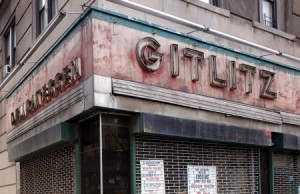 Nevada Market (80th and Broadway): Steaks. Chops. Chicken. Citarella’s (74th and Broadway): Everything fresh from the sea. Paramount Famous Jewish Dairy Restaurant (72nd west of Broadway): Blintzes. Gefilte fish. Kasha varneshkes. Steinberg’s (84th and Broadway): Same cuisine as Paramount but classier. Very good herring. Great Shanghai (98th and Broadway) Chinese lobster and shrimp dishes. Dumplings. Szechuan (95th and Broadway) Fire on a plate. New York’s first and best Szechuan restaurant. Broadway Nut Shop. (East side of Broadway and 81st): Encyclopedic array of fresh roasted nuts, dried fruits and candy treats from across the globe. Eclair Bakery and Restaurant (72nd Street): Vienna, Berlin, Budapest and Warsaw transplanted in New York. Senate Cafeteria (96th and Broadway): Where I.B. Singer ate his tunafish salad in the company of tea sipping, Yiddish speaking European survivors.
Nevada Market (80th and Broadway): Steaks. Chops. Chicken. Citarella’s (74th and Broadway): Everything fresh from the sea. Paramount Famous Jewish Dairy Restaurant (72nd west of Broadway): Blintzes. Gefilte fish. Kasha varneshkes. Steinberg’s (84th and Broadway): Same cuisine as Paramount but classier. Very good herring. Great Shanghai (98th and Broadway) Chinese lobster and shrimp dishes. Dumplings. Szechuan (95th and Broadway) Fire on a plate. New York’s first and best Szechuan restaurant. Broadway Nut Shop. (East side of Broadway and 81st): Encyclopedic array of fresh roasted nuts, dried fruits and candy treats from across the globe. Eclair Bakery and Restaurant (72nd Street): Vienna, Berlin, Budapest and Warsaw transplanted in New York. Senate Cafeteria (96th and Broadway): Where I.B. Singer ate his tunafish salad in the company of tea sipping, Yiddish speaking European survivors.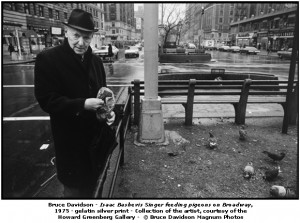
As HG remarked, this is just a smattering. There was much more. Sadly, only Zabar’s, Greengrass and Citarella’s remain. On the bright side: The West Side has added Fairway.
Zero
April 28th, 2011 § 0 comments § permalink
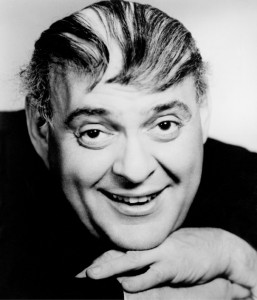 Zero Mostel portrait on last post spurred HG thoughts about that comic genius/egomaniac/monster. He got his unusual name when he made his debut at the Cafe Society night club in Greenwich Village. He had no background. No reputation. Therefore, he was dubbed “Zero.” Of course, he was a sensation and his career took off like a comet until he was blacklisted in the Joe McCarthy Red Menace era. Zero named no names and rebuffed the inquisitors. He retired to his studio in the wholesale flower district of Manhattan and painted. He was quite a good painter. He outlasted McCarthy and triumphed in film with “The Producers,” and on Broadway with “Fiddler on the Roof,” and many other plays.
Zero Mostel portrait on last post spurred HG thoughts about that comic genius/egomaniac/monster. He got his unusual name when he made his debut at the Cafe Society night club in Greenwich Village. He had no background. No reputation. Therefore, he was dubbed “Zero.” Of course, he was a sensation and his career took off like a comet until he was blacklisted in the Joe McCarthy Red Menace era. Zero named no names and rebuffed the inquisitors. He retired to his studio in the wholesale flower district of Manhattan and painted. He was quite a good painter. He outlasted McCarthy and triumphed in film with “The Producers,” and on Broadway with “Fiddler on the Roof,” and many other plays.
HG remembers waiting before the smoked fish counter at Zabar’s, the renowned food emporium on the Upper West Side. Zero was there and he and HG chatted and expressed mutual admiration for Zabar’s Russian pumpernickel bread. HG told Zero pumpernickel and chicken fat had been his favorite after school snack. Commented Zero: “Pumpernickel and chicken fat killed more Jews than Hitler.”